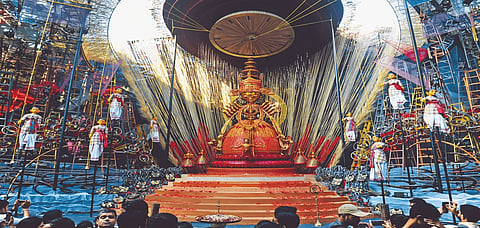

Dr Tapati Guha-Thakurta's seminal work, "In The Name of The Goddess The Durga Pujas of Contemporary Kolkata," unravels the festival's transition over the years from a largely community-led celebration to a grand spectacle, where the pandal has become a locus of celebration, art, and conversation.
Her wealth of knowledge collected while researching for the book and genuine admiration for a festival she's grown up watching led her to explore the festival's evolution into an extravaganza and champion its status as an Intangible Cultural Heritage.
Why did you choose Durga Puja as the subject of your decade-long research
I think the Durga Puja of Kolkata had evolved and emerged in a way that warranted scholarly attention and research of a different kind. Even though the media has covered it extensively, a different kind of academic work hasn't been done before.
Is there any aspect of the Puja that you specifically wanted to study
I have grown up in the city and have participated as a spectator all these years. I had never been a part of it as a researcher before. But at the turn of the 21st century, Durga Puja seemed to have taken on a different aesthetic and artistic dimension that caught my attention. I also wanted to understand how the neighbourhoods underwent a significant change during Puja and over the years.
How have you seen Durga Puja evolve over the years through your research
Everything about it has changed. Earlier, it was small in terms of budget and space&ndashthere used to be a small park where the Pujo would happen, and it used to be strictly community-led. But now, the celebrations have taken on a thematic character and have become extravagant.
The urban festival is now characterised by spectacle, competition and recreation elements. The pandals have become more elaborate and conceptual. It has also become an excellent platform for voicing many political and social concerns that may have little to do with the goddess.
How has this trend, where Durga Puja has become a spectacle, impacted the artists or the image-makers
While studying the neighbourhood, we also focused on how a new aesthetic was developing. A new category of designers and folk artists has entered the world of Durga Puja production. The traditional image-makers and pandal-makers have now also been joined by a new category of small-time artists and designers who envision Puja as public art.
What was the process of creating a nomination dossier for UNESCO like
It was a new assignment for me after I had completed my book in 2015. So, some new research was done. The UNESCO form is long and requires a detailed but concise understanding of the festival. They were interested in the community and other stakeholders, its evolution to the contemporary form, the extent of commercialisation, and its environmental impact.
How do you think UNESCO's recognition impacts the celebrations hereon
Now a lot of rules and regulations are coming into play. With the UNESCO tag, there will be more emphasis on it. There is a lot of celebration, but a lot of rules and guidelines are also there that need to be followed. The attempt will now be to give it an international quality and attain more global recognition&ndashwhich it should, for it is one of the world's most extraordinary public art events.
